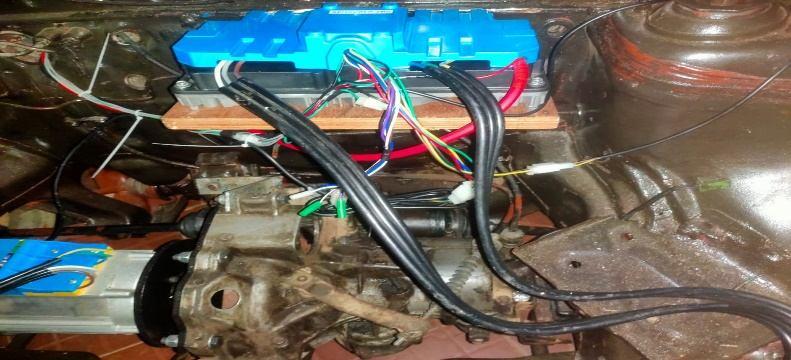
4 minute read
International Journal for Research in Applied Science & Engineering Technology (IJRASET)
from Solar Powered E-Car
by IJRASET
ISSN: 2321-9653; IC Value: 45.98; SJ Impact Factor: 7.538
Volume 11 Issue IV Apr 2023- Available at www.ijraset.com
Advertisement
Battery capacity = 100Ah Charge current rating = 15ACharger voltage = 60 V

E-Car (LeadAcid battery over all efficiency) = 80-85 % Charge period = (Battery power in amper-hour x DOD) / (Charge flow in Amps x Efficiency of the charge) = (100 x 50%) / (15 x 85%) = 3.92 hours = 4 hoursApprox
The charge controller is a tool that stops overcharging and over-discharging of solar batteries. Batteries cannot be overly drained or overly recharged, which is one of their most prevalent issues. By correctly controlling the battery voltage and current, a charge controller regulates the charge. Charge controllers are designed to maintain the solar system's effectiveness while protecting the battery and giving it the longest feasible life. The fact that charge controllers only manage DC loads should be noted.
V. BATTERYAND SOLAR PANELCALCULATIONS
1) To calculate battery capacity in watt hours, multiply battery voltage by battery amp hours. Battery capacity thus equals 12 × 100 x 5 = 6000 Wh.
2) To determine how much of the battery's capacity has been depleted, multiply battery watt hours by battery depth of discharge.


3) Assume the battery is 50% drained.
4) After then, the discharged battery capacity (Watt-Hour) is equal to 6000 x 50%=3000 (Watt-Hour).
5) To calculate the amount of energy needed to fully charge the battery after accounting for charging losses, divide the capacity of the battery after it is depleted by the battery's rule-of-thumb charge efficiency factor (lead acid: 85%; lithium: 99%).
6) Assume for the moment that we utilise lead-acid batteries. Secondly, at 85% efficiency
7) The energy needed for a complete charge is hence 3000 x 85% = 3529 Wh (watt-hour).
8) To estimate solar output, multiply the wattage of the solar panels by the charge controller's efficiency (PWM: 75%; MPPT: 95%).
ISSN: 2321-9653; IC Value: 45.98; SJ Impact Factor: 7.538

Volume 11 Issue IV Apr 2023- Available at www.ijraset.com
9) We are utilising an MPPT charge controller and a 200W solar array. Thus, solar output is equal to 200 x 0.95 = 190 W.

10) To account for system losses, multiply the solar output by 100% minus a certain percentage.
11) I'll use the default value for system losses from the PV Watts Calculator at the National Renewable Energy Laboratory, which is 14.08% in this case.
12) 190 x (100% - 14.08%) = 163.248 W is the adjusted solar output.
13) To calculate your projected charge time, divide the amount of energy needed to fully charge the battery (in watt hours) by the modified solar output (in watts).
Charge Time thus equals 3529/163.248 =21.86 hours
VI. BATTERYAND SOLAR PANEL

Desinging
VII. BATTERY CHARGINGTIME -WHEN IT IS CHARGED THROUGH AN SOLAR PANEL
In a similar manner, the charging time is determined and will be as follows if the battery is to be charged from 100% of DOD, Watt-hours in a discharged battery equal 6000 x 100%= 6000 Wh.
Charge Time: 5100/163.248 = 31.24 hours
Energy Required: 6000 x 85% = 5100 Wh
Charge Required: 5100 Wh
VIII. CIRCUIT DIAGRAM

ISSN: 2321-9653; IC Value: 45.98; SJ Impact Factor: 7.538

Volume 11 Issue IV Apr 2023- Available at www.ijraset.com
Through the employment of a charge controller, the batteries are charged with the help of the 200-watt solar panels. Under moderate sunlight, the batteries may be charged in around 37 hours. The battery pack can also be charged quickly using a plug-in charger; this process takes the batteries about 3 hours. A PMSM motor is powered by a controller using five 12-volt, 100-amp-hour batteries connected in series. For protection, an MCB is installed between the batteries and PMSM controller. According to the acceleration throttle position, the controller delivers the necessary output power, and the motor is connected to the car's gearbox, which transmits mechanical power from the PMSM drive to the wheels' shafts.
Attach the engine to a 4-speed gearbox coupler and fit it to the gearbox using the pressure plate, clutch plate, and flywheel after removing any unneeded parts of the automobile, such as the gasoline tank and the silencer.By doing this, we can convert our combustion engine into an electrical one that uses less energy and runs more quickly and effectively. This car has series-connected lead-acid batteries with a 12V and 100ah capacity, a 3000w PMS motor, and a 100ah controller. On road testing of this car produced great results. Due to the use of lead acid batteries, the solar E-car has a range of 50 to 60 kilometres and a top speed of 60 km/h with 4 passengers. Its gross weight is 800 kg.The manual gear mechanism provides the essential torque needed for movement while increasing the motor's rpm from 3000 to 6000. electric current flowing from a solar panel array into a battery pack. Thereafter, the previously saved energy will be used to power a PMS motor.
IX. CONCLUSION
The project's aim is to create a less expensive Solar-Powered E-Car. The aim is that the solar-powered E-car is intended for a range of about 50-60 kilometres. Because it lacks of harmful gases and other pollutants, the solar car is very cost-effective for contemporary mobility.

References
[1] “Global EV Outlook 2020 - Prospects for electrification in transport in the coming decade (Technology report),” International Energy Agency, 2020. https://www.iea.org/reports/global- ev-outlook2020#prospects-for-electrification-in-transport-in-the-coming-decade(accessed Sep. 14, 2020).
[2] Permanent-Magnet Synchronous MachineDrives Adhavan Balashanmughamand Mockaisamy Maheswaran.
[3] Permanent Magnet Synchronous and Brushless DC Motor Drives R. Krishnan Electrical and Computer Engineering Department Virginia Tech Blacksburg, Virginia, U.S.A
[4] T. Nazghelichi, F. Torabi, V. Esfahanian, Prediction of temperature behavior of a lead- acid battery by means of Lewis number, Electrochim. Acta 275 (2018) 192–199, doi: 10.1016/J. ELECTACTA.2018.04.092.
[5] ]. P. Krivík, Changes of temperature during pulse charging of lead acid battery cell in a flooded state, J. Energy Storage 14 (2017) 364–371, doi: 10.1016/J.EST.2017.03.018.
[6] Chopra, K.L., Paulson, P.D. and Dutt, V. (2004) Thin-Film Solar Cells: An Overview. Progressin Photovoltaics, 12, 69-92. http://dx.doi.org/10.1002/pip.541
[7] Retrieved from: http://dspace.bracu.ac.bd/xmlui/bitstream/10361/9118/12221046%2C%2EE.pdf
[8] Suresh V 2019Forecasting solar PV output using convolutional neural networks with a sliding window algorithm. Retrieved from: https://www.mdpi.com/1996-1073/13/3/723


